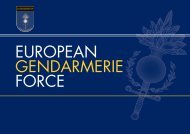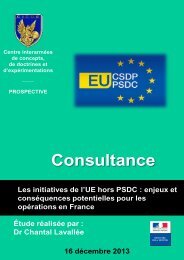Conference
science-research-bulletin-2013-conference
science-research-bulletin-2013-conference
Create successful ePaper yourself
Turn your PDF publications into a flip-book with our unique Google optimized e-Paper software.
EUROPEAN POLICE SCIENCE AND RESEARCH BULLETIN<br />
SPECIAL CONFERENCE EDITION<br />
The general public often wonders why there are<br />
such differences between status, relationship<br />
to the majority, and behaviour of the Roma<br />
in different Slovenian regions, for example in<br />
the Prekmurje vs. Dolenjska regions (Šuklje &<br />
Banutai, 2012). Novak (personal interview, 20.<br />
4. 2012) explains that the main reason for such<br />
difference is that most Roma from the Prekmurje<br />
region own the land and farms they live on,<br />
Roma in the Dolenjska region, on the other hand,<br />
are in most cases still not rightful owners of the<br />
land they live on. Novak adds that the situation<br />
depends on local politics and local inhabitants’<br />
will to deal with these shifts. Of course we<br />
should not forget the historical background of<br />
the area. People living by the Mura River have<br />
become accustomed to the constant shifting of<br />
rulers and authorities, which was accompanied<br />
by mass migrations. The main reasons for the<br />
differences between various ‘Roma groups’ are<br />
the (in)ability to legally own property, interests<br />
of local community, politics and the functioning<br />
of the government. Other reasons relate to<br />
the attitude of the majority — acceptance of<br />
fellow inhabitants that are different and higher<br />
tolerance thresholds (Šuklje & Banutai, 2012).<br />
Fajon (2011) suggests that activities that empower<br />
Roma communities produce results, stressing<br />
the example of city of Murska Sobota, the<br />
administrative centre of Pomurje region, where<br />
the Roma are better integrated into society then<br />
elsewhere. Murska Sobota had the first ever Roma<br />
representative in a Slovene city council and has a<br />
Commission for Roma questions to deal with their<br />
actual problems. Several programmes have been<br />
put in place providing social and pedagogical<br />
assistance to families, supporting integration into<br />
society, and organising sport and cultural activities.<br />
The Pušča settlement nearby the Murska Sobota<br />
is the best example of cooperation and cohabitation<br />
of Roma and non-Roma communities<br />
in Europe today (Fajon, 2011: 114). In Fajon’s view,<br />
the small village is important for Slovenia and<br />
for the European Union in that it demonstrates<br />
that the cooperation and integration of Roma<br />
into society is possible and models the way to<br />
accomplish it. In Pušča there is a kindergarten,<br />
Roma have their own fire brigade and they are<br />
involved in many associations that promote their<br />
interests. They also plan to open a music school<br />
for Roma and non-Roma kids.<br />
POLICING THE ROMA<br />
COMMUNITIES IN SLOVENIA<br />
The relation between the police and Roma<br />
communities is crucial in many ways. As we<br />
have seen, Roma are often the target of racially<br />
motivated discrimination and violence. They<br />
need to be able to fully rely on the police for<br />
protection against, and the full investigation of,<br />
hate-motivated crimes. At the same time, the<br />
police face the challenge of effectively policing<br />
Roma and Sinti communities that often view<br />
such efforts with suspicion and mistrust, due<br />
to a long history of abuse and discrimination<br />
at the hands of various state authorities (OSCE,<br />
2010). Being one of the most exposed pieces of<br />
the state apparatus, the police are implicated in<br />
the previously mentioned Roma issue. Locally,<br />
they deal with security issues involving Roma<br />
people being lawbreakers as well as victims<br />
on a daily basis. Unofficial estimates suggest<br />
that patterns of law violation vary according to<br />
ethnic category in some parts of Slovenia (Strobl,<br />
Haberfeld, Banutai & Duque, 2012). The role<br />
of police in security issues related to the Roma<br />
population can be limited to the tasks that are<br />
regulated by law. On the other hand, it can be<br />
understood more broadly as providing versatile<br />
help to other organisations and partnerships<br />
among Roma people and the local community<br />
(Ogulin, Brodarič, Ribič & Gorenak, 2005).<br />
As in other countries, in Slovenia police have<br />
adopted community policing philosophies and<br />
practices. The key figure of community policing<br />
within the framework of the Slovenian police is<br />
the community policing officer (hereinafter: CPO)<br />
(Police, 2012). Police officers with long-standing<br />
experience and communication abilities are<br />
usually appointed for CPOs. The official web page<br />
of the Slovenian police (Police, 2012) includes the<br />
names of all 317 CPOs in Slovenia as well as basic<br />
information about the tasks of CPOs, instructions<br />
on when to call for a CPO and an appeal to help<br />
create favourable security conditions (Lobnikar &<br />
Meško, 2010). CPOs’ tasks are defined in Police<br />
rules, Strategy for community-oriented policing,<br />
Guidelines for prevention work and Measures<br />
for the improvement of community-oriented<br />
policing (Meško & Lobnikar, 2005; Virtič &<br />
Lobnikar, 2004) and the late one form 2013<br />
Community Policing (Police, 2013). Community<br />
policing is a subject covered during basic police<br />
training at the Police Academy and later at<br />
CPO trainings. CPOs as well as heads of police<br />
67





